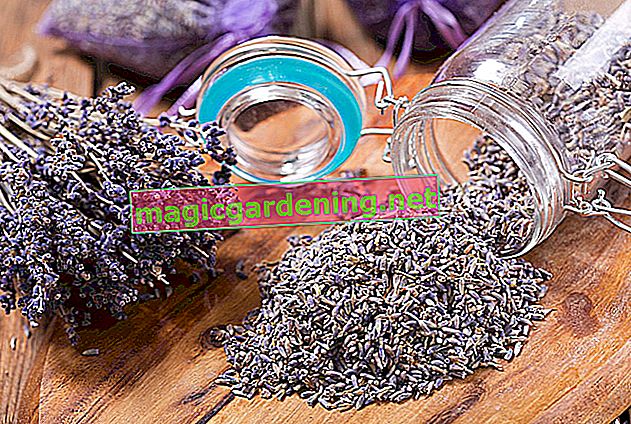
Dry lavender
The plant should be dried as soon as possible, but gently, after harvesting in order to preserve the ingredients and aroma as best as possible. The aim is to remove all moisture from the herb, but without destroying the volatile essential oils. If they are dried at too high temperatures, they will naturally degrade. So it depends on the right combination of temperature and humidity. A temperature of 38 ° C is ideal for drying; only special dryers can do that. Ideal conditions are difficult to achieve in the home, a healthy amount of improvisation counts here.
also read
- Combine lavender correctly
- Caring for lavender in the pot properly
- The right way to transplant lavender - the best tips & tricks
Where do lavender dry?
Well-suited drying rooms are poorly insulated attics, garden houses or sheds. It is important that the rooms heat up well in summer and can also be ventilated. The ideal place should be dry, have little humidity and also be as dark as possible.
Dry the lavender leaves
In the case of lavender, the young leaves in particular are harvested, dried and used as a kitchen spice. Just before flowering, the delicate leaves have the most intense aroma - like almost all herbs. Cut the leaves with their stems, bundle them into small bunches and hang them up with the shoot tips facing down. It is important that the individual bouquets do not hang too closely; The air must be able to circulate well for quick drying. Larger leaves, on the other hand, are picked individually and laid out on grids or paper. After three to four days, most of the leaves are dry; you can tell when they crackle when touched. The leaves are then stripped from the stems and crumbled.
Lavender as a kitchen spice
Young lavender leaves season fish dishes, stews, soups and poultry. But be careful: Use the very aromatic herb only sparingly, even small amounts are enough. The dried leaves should be cooked as this is the best way to give off their aroma. Incidentally, lavender - especially the flowers - belongs to the traditional herbal mixture “Herbs of Provence”. The spice also tastes delicious in herb butter, along with other Mediterranean herbs.
Drying lavender flowers
The flower harvest is best done shortly after full bloom. Larger flowers are harvested individually and laid out to dry. If, on the other hand, the flowers are very small - as is the case with most types of lavender - the inflorescences are cut with stems, bundled and dried as described for the leaves. You can then chop the dried flowers, but you can also store them whole and only chop them up when you use them. This way, even more of the intense aroma is retained.
Mix a sachet
Whether for the linen cupboard or as a potpourri for a pleasant room scent, mix your own scented sachet! To do this, mix lavender flowers, leaves of the lemon-scented lemon balm and rose blossoms - naturally dried and chopped up - in roughly the same proportion and pack this combination in a linen or cotton bag. Loop this up loosely and place in a dry place of your choice. Incidentally, this mixture is suitable, poured boiling water over it and steeped for about 15 minutes - also great as an additive for bath water.
Store dried lavender properly
After drying, the lavender or its individual components are crushed and packed in clean, airtight and opaque containers or paper bags. So dried lavender can be stored for up to a year.
Other ways of preserving lavender
Classically, lavender is preserved by drying it. However, there are other ways to further process fresh or dried lavender. For example, lavender sugar or lavender honey are very popular, but also aromatic lavender oil.
Sweet lavender
Sugar is ideal for preserving the wonderful aroma of lavender. The flowers (and maybe also leaves) are dried, crumbled and mixed with commercial sugar. This is how the aroma of the lavender is transferred to the sugar. Lavender sugar lasts a long time and is ideal for sweetening teas, baked goods and desserts. Lavender honey is also very easy to make. Proceed as follows:
- Heat the honey to around 40 ° C so that it liquefies.
- Now mix the liquid honey with the dried lavender flowers.
- Pour the mixture into an airtight jar.
- Store this at a constant temperature.
- The lavender honey is ready as soon as the flowers have dissolved.
- The honey tastes good as a spread, in tea or in warm milk.
Lavender oil
Lavender oil is also not difficult to make. Fill clean glass bottles halfway with fresh leaves and flowers. The bottles are then filled with a high-quality but tasteless cooking oil and sealed tightly. To avoid mold growth, it is important that the herbs are completely covered with oil. The filled bottles should stand in a warm place for about a week. Then the oil is sifted through a cloth and again filled into clean bottles. If the taste of the oil is not intense enough, the process can be repeated several times. Store the oil in a cool and dark place. If it becomes cloudy, it can no longer be used.
Tips & Tricks
The intensely fragrant lavender is one of the aphrodisiacs - the “plants of love”. No wonder, since the herb is said to have a blood circulation-promoting, strengthening and stimulating effect.
IJA

The garden journal freshness-ABC
How can fruit and vegetables be stored correctly so that they stay fresh as long as possible?
The garden journal freshness ABC as a poster:
- Order here cheaply as an A3 print for your kitchen
- as a free PDF file to print out yourself








